The world's smallest spectrometer UPRtek MK350D
Color temperature and color rendering indices are very important for high-quality lighting, but they cannot be measured by simple means.
In the spring, I wrote about the spectrometer UPRtek MK350N and promised to talk about the pocket spectrometer MK350D. Keep the promise.
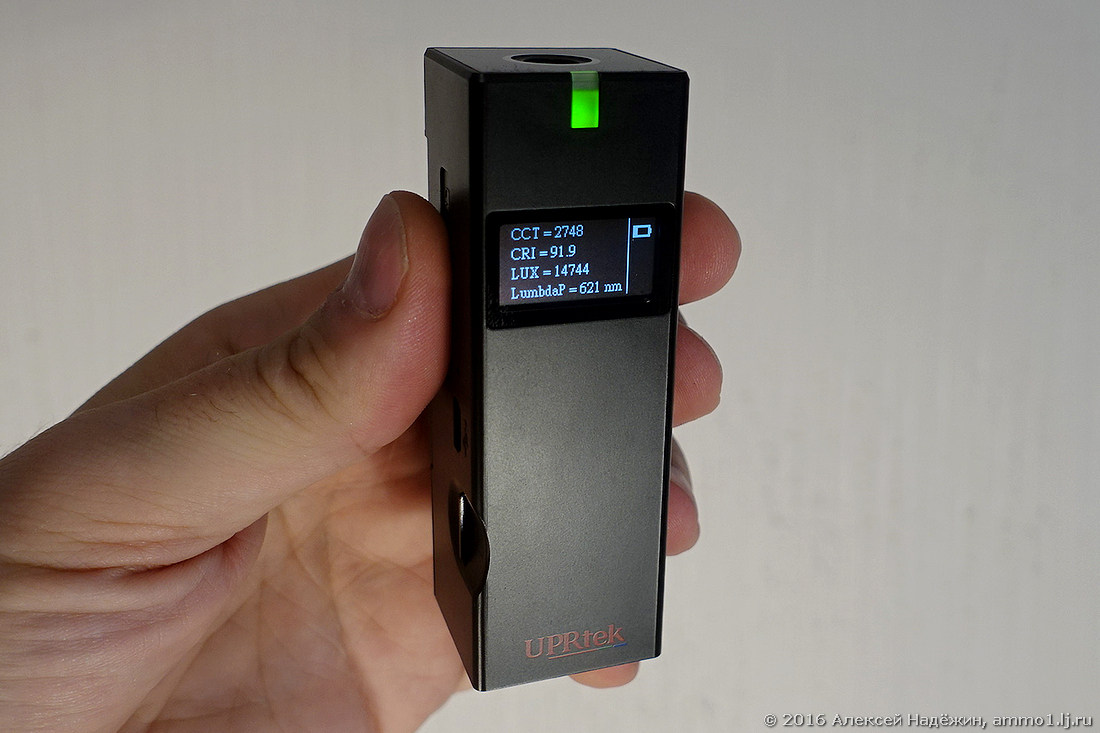
')
Spectrometer UPRtek MK350D measures the spectrum of light, calculates the color temperature and color rendering index. In addition, it works as a light meter and a light pulsation meter.
This device for the project Lamptest was provided by the St. Petersburg company INTECH Engineering , which participated in the development of the spectrometer and the writing of mathematical models. The instrument is manufactured by Taiwanese company UPRtek , in the assortment of which there are five models of spectrometers:
MF250N - autonomous spectrometer-heart rate monitor.
MK350N - the basic model of the spectrometer;
MK350N Plus - spectrometer with the measurement of the pulsation of light;
The MK350D is a compact spectrometer with light pulsation measurement;
The MK350S is a spectrometer with measurement of light pulsation and advanced capabilities (lux view, comparison of two measurements, measurement of parameters for phytolighting and photo-filming).
Spectrometers are professional equipment, and, as you know, professional equipment cannot be cheap.
The MK350N costs $ 1,600, the MK350D costs $ 1,700, the MK350N + $ 2,200, the MK350S $ 2,900.
The budget spectrometer MF250N, which does not have an SD card and the ability to connect to a computer, costs $ 900.
UPRtek MK350D is the smallest spectrometer in the world - its dimensions are 30x33x90 mm, weight - 73 g.
It can work autonomously, displaying the measured data on its indicator and saving it to the MicroSD card, can connect to the smartphone via Bluetooth and be controlled from the smartphone, can connect to the computer via USB and be controlled from the computer.
The device operates in the range of visible light 380-780 nm. The optical system of the spectrometer using a diffraction grating splits light into a spectrum that is analyzed by a 400-point linear CMOS sensor.
On the left side of the case, there is an on / off / switching indication button, a MiniUSB connector, a microSD card slot, a reset button hole. On the upper face is a measurement start button. In front is a four-line monochrome OLED screen and a status LED.
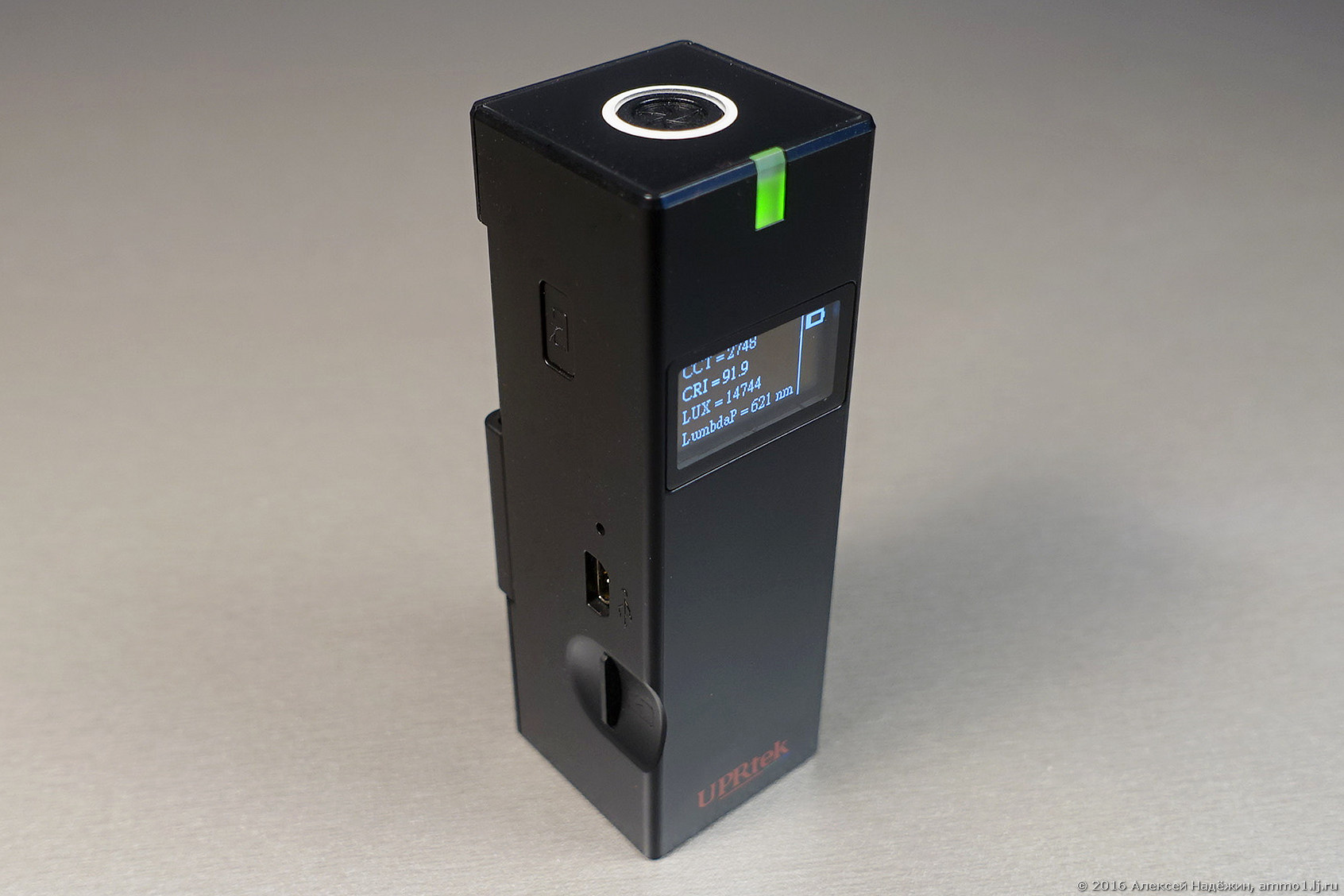
Behind there are two windows of light sensors (one for measuring the spectrum, the second for measuring the pulsation of light) and a curtain covering these windows. The shutter must be closed for calibration, which starts each time the spectrometer is turned on.

Although the device is ultra-compact, there is a thread on the bottom to install the device on a tripod.

Included - a case, a lanyard for carrying a spectrometer around the neck with a mount to the thread for a tripod, a USB-MiniUSB cable, instructions, a certificate. The spectrometer is supplied in a metal case.

The result of each measurement is displayed on the instrument screen. The side button can switch four screens. On the first one - color temperature (CCT), color rendering index (CRI), illumination (LUX), peak wavelength (Lambda P). On the second - the spectrum. The third is the color coordinates for CIE1931 and CIE1976. On the fourth - the transfer coefficient of pink (R9), illumination (LUX), illumination in candles per foot (fc), the ripple coefficient (Flicker).

The results of each measurement device saves to the microSD card as an xls file. This file contains all the calculated data and the level values for all 400 points of the spectrum.

The MK350D smartphone application allows you to remotely start the measurement process and see the results on the smartphone screen.
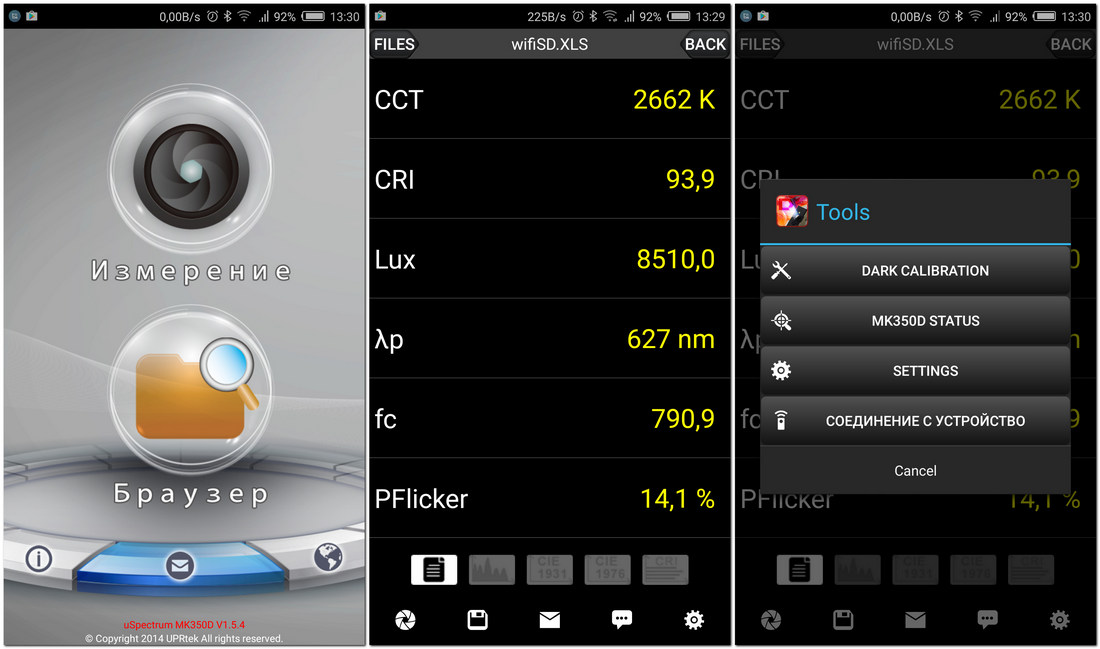

The uSpectrum program for Windows allows you to control the spectrometer, get results from it, and also process XLS files without connecting the spectrometer.


In addition to measuring the spectrum and parameters associated with it, the UPRtek MK350D measures pulsation and illumination. The ripple coefficient is calculated by the formula:

Emax - the maximum value of illumination for the period of its oscillation, Emin - the minimum value of illumination for the same period.
This was the end of the review, but I decided to conduct several experiments, see what the spectra of different light sources look like, and make sure that the UPRtek MK350D spectrometer is accurate.
One way to check the spectrometers is to analyze the glow of the flame, which heats the wire rubbed with a solution of sodium chloride. The flame turns yellow and the wavelength of such light is 589 nm.

The peak in the spectrum measured by the UPRtek MK350D instrument accounts for exactly 589 nm. Excellent result!

Red laser 635 nm. The peak measured by the spectrometer was at 633 nm.

Green laser 532 ± 10 nm. The peak occurred at 531 nm, and the entire emission spectrum of the laser lies in the range of 524–540 nm.
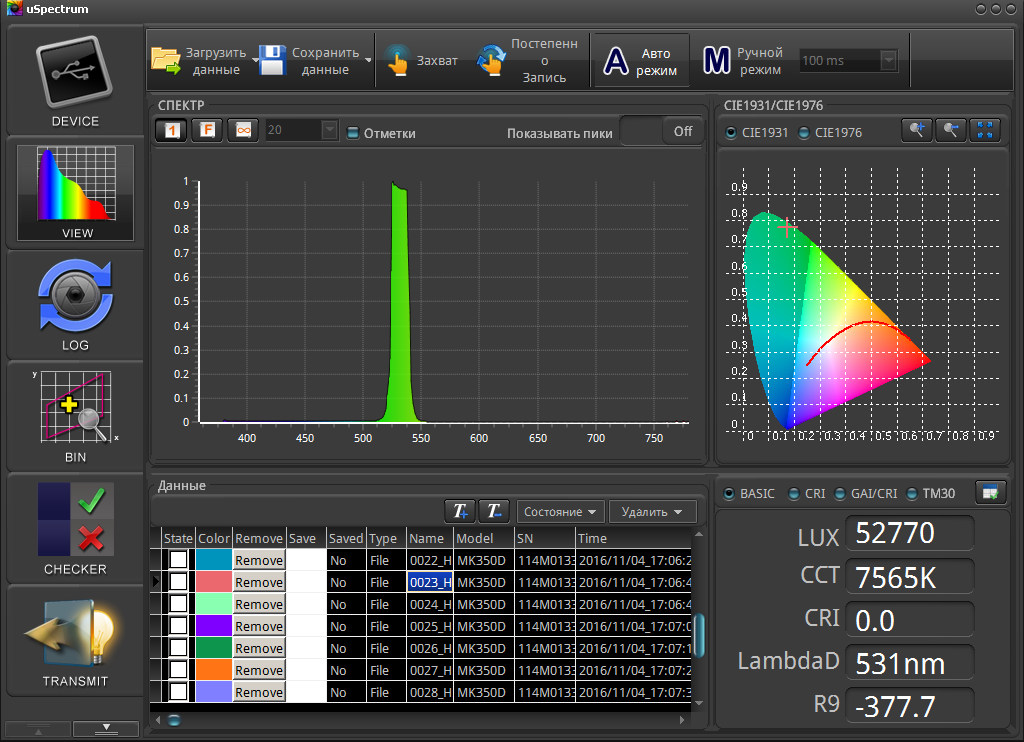
Red LED.

Green LED.

Blue LED.
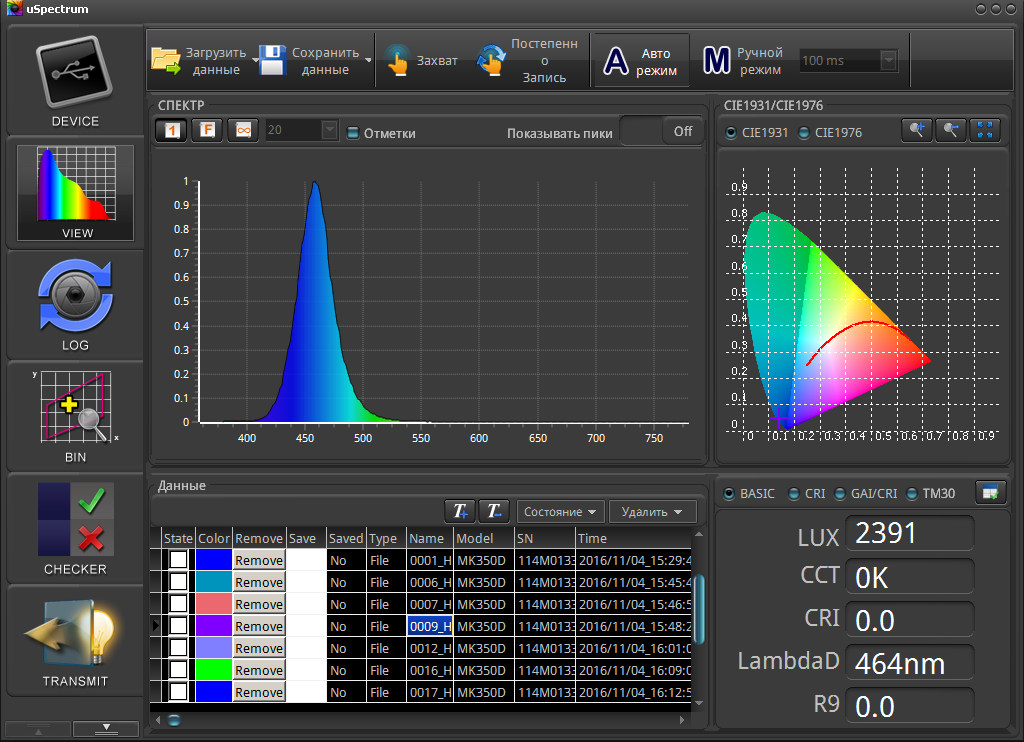
Incandescent lamp.

Fluorescent lamp Ecola Light Spiral ELH / 15W .
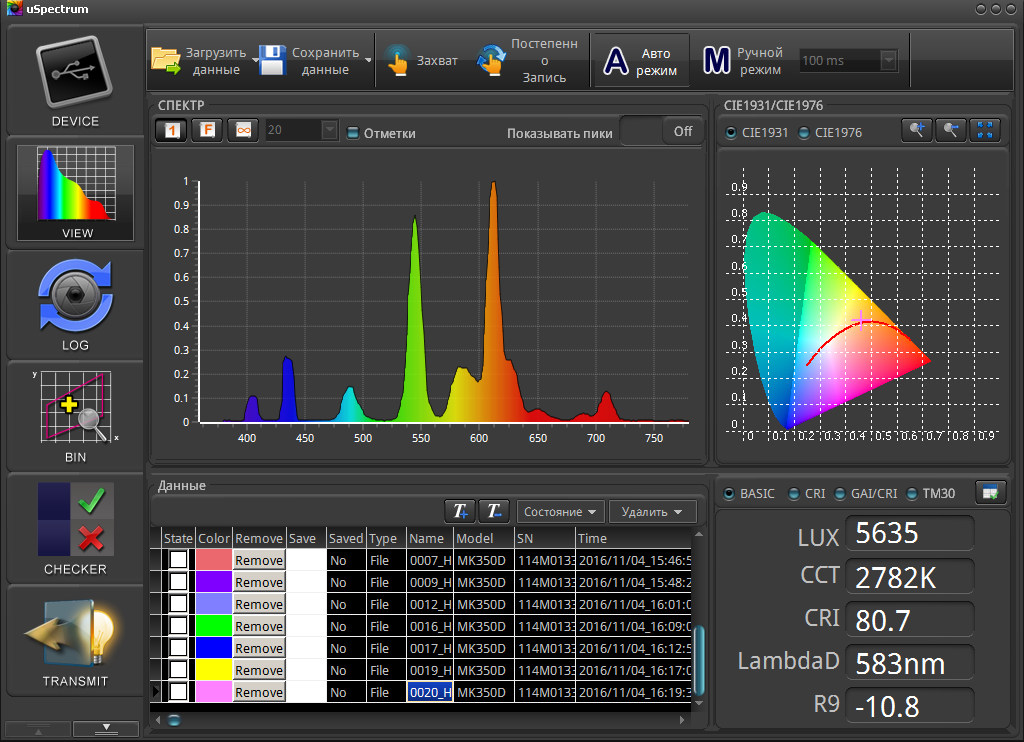
Bad 9W LED COB CRI: 61.9, R9: -63.

Not very good LED light ASD LED-A60-std 7W E27 3000K CRI: 72.4, R9: -23.6.

Good LED lamp Lisma SDF-6 A50 CRI: 81.2, R9: 4.5.

Very good LED lamp IKEA 902.552.90 E14 LED1012G5 CRI: 95.2, R9: 78.9.

Many thanks to INTECH Engineering and personally to Alexey Pankrashkin, General Director of this company, for the spectrometer. All measurements of color temperature, color rendering index, R9 pink color transfer index and ripple coefficient when tested on lamptest.ru are now performed using the MK350D.
ps Today, November 8, the Interlight Moscow exhibition will start at the Moscow Expocenter, most of which will be devoted to LED lamps. I will definitely be there this afternoon, and most likely one more day - the exhibition will last until November 11th. I will have a spectrometer with me, so if you want to know the color rendition index (CRI), the ripple coefficient and the color temperature of your lamps, come with them to the exhibition and look for me there. Free tickets here . Look for me in the Telegram by nickname ammo1.
© 2016, Alexey Nadyozhin
In the spring, I wrote about the spectrometer UPRtek MK350N and promised to talk about the pocket spectrometer MK350D. Keep the promise.

')
Spectrometer UPRtek MK350D measures the spectrum of light, calculates the color temperature and color rendering index. In addition, it works as a light meter and a light pulsation meter.
This device for the project Lamptest was provided by the St. Petersburg company INTECH Engineering , which participated in the development of the spectrometer and the writing of mathematical models. The instrument is manufactured by Taiwanese company UPRtek , in the assortment of which there are five models of spectrometers:
MF250N - autonomous spectrometer-heart rate monitor.
MK350N - the basic model of the spectrometer;
MK350N Plus - spectrometer with the measurement of the pulsation of light;
The MK350D is a compact spectrometer with light pulsation measurement;
The MK350S is a spectrometer with measurement of light pulsation and advanced capabilities (lux view, comparison of two measurements, measurement of parameters for phytolighting and photo-filming).
Spectrometers are professional equipment, and, as you know, professional equipment cannot be cheap.
The MK350N costs $ 1,600, the MK350D costs $ 1,700, the MK350N + $ 2,200, the MK350S $ 2,900.
The budget spectrometer MF250N, which does not have an SD card and the ability to connect to a computer, costs $ 900.
UPRtek MK350D is the smallest spectrometer in the world - its dimensions are 30x33x90 mm, weight - 73 g.
It can work autonomously, displaying the measured data on its indicator and saving it to the MicroSD card, can connect to the smartphone via Bluetooth and be controlled from the smartphone, can connect to the computer via USB and be controlled from the computer.
The device operates in the range of visible light 380-780 nm. The optical system of the spectrometer using a diffraction grating splits light into a spectrum that is analyzed by a 400-point linear CMOS sensor.
On the left side of the case, there is an on / off / switching indication button, a MiniUSB connector, a microSD card slot, a reset button hole. On the upper face is a measurement start button. In front is a four-line monochrome OLED screen and a status LED.

Behind there are two windows of light sensors (one for measuring the spectrum, the second for measuring the pulsation of light) and a curtain covering these windows. The shutter must be closed for calibration, which starts each time the spectrometer is turned on.

Although the device is ultra-compact, there is a thread on the bottom to install the device on a tripod.

Included - a case, a lanyard for carrying a spectrometer around the neck with a mount to the thread for a tripod, a USB-MiniUSB cable, instructions, a certificate. The spectrometer is supplied in a metal case.

The result of each measurement is displayed on the instrument screen. The side button can switch four screens. On the first one - color temperature (CCT), color rendering index (CRI), illumination (LUX), peak wavelength (Lambda P). On the second - the spectrum. The third is the color coordinates for CIE1931 and CIE1976. On the fourth - the transfer coefficient of pink (R9), illumination (LUX), illumination in candles per foot (fc), the ripple coefficient (Flicker).

The results of each measurement device saves to the microSD card as an xls file. This file contains all the calculated data and the level values for all 400 points of the spectrum.

The MK350D smartphone application allows you to remotely start the measurement process and see the results on the smartphone screen.


The uSpectrum program for Windows allows you to control the spectrometer, get results from it, and also process XLS files without connecting the spectrometer.


In addition to measuring the spectrum and parameters associated with it, the UPRtek MK350D measures pulsation and illumination. The ripple coefficient is calculated by the formula:

Emax - the maximum value of illumination for the period of its oscillation, Emin - the minimum value of illumination for the same period.
This was the end of the review, but I decided to conduct several experiments, see what the spectra of different light sources look like, and make sure that the UPRtek MK350D spectrometer is accurate.
One way to check the spectrometers is to analyze the glow of the flame, which heats the wire rubbed with a solution of sodium chloride. The flame turns yellow and the wavelength of such light is 589 nm.

The peak in the spectrum measured by the UPRtek MK350D instrument accounts for exactly 589 nm. Excellent result!

Red laser 635 nm. The peak measured by the spectrometer was at 633 nm.

Green laser 532 ± 10 nm. The peak occurred at 531 nm, and the entire emission spectrum of the laser lies in the range of 524–540 nm.

Red LED.

Green LED.

Blue LED.

Incandescent lamp.

Fluorescent lamp Ecola Light Spiral ELH / 15W .

Bad 9W LED COB CRI: 61.9, R9: -63.

Not very good LED light ASD LED-A60-std 7W E27 3000K CRI: 72.4, R9: -23.6.

Good LED lamp Lisma SDF-6 A50 CRI: 81.2, R9: 4.5.

Very good LED lamp IKEA 902.552.90 E14 LED1012G5 CRI: 95.2, R9: 78.9.

Many thanks to INTECH Engineering and personally to Alexey Pankrashkin, General Director of this company, for the spectrometer. All measurements of color temperature, color rendering index, R9 pink color transfer index and ripple coefficient when tested on lamptest.ru are now performed using the MK350D.
ps Today, November 8, the Interlight Moscow exhibition will start at the Moscow Expocenter, most of which will be devoted to LED lamps. I will definitely be there this afternoon, and most likely one more day - the exhibition will last until November 11th. I will have a spectrometer with me, so if you want to know the color rendition index (CRI), the ripple coefficient and the color temperature of your lamps, come with them to the exhibition and look for me there. Free tickets here . Look for me in the Telegram by nickname ammo1.
© 2016, Alexey Nadyozhin
Source: https://habr.com/ru/post/398921/
All Articles